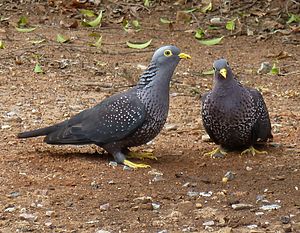Olive pigeon
| Olive pigeon | ||||||||||
|---|---|---|---|---|---|---|---|---|---|---|

Olive pigeon ( Columba arquatrix ) |
||||||||||
| Systematics | ||||||||||
|
||||||||||
| Scientific name | ||||||||||
| Columba arquatrix | ||||||||||
| Temminck , 1809 |
The olive pigeon ( Columba arquatrix ), also called spotted pigeon , spotted wood pigeon , yellow-eyed pigeon or purple pigeon , is a species of pigeon birds that is assigned to the subfamily Columbinae . The species occurs exclusively in Africa.
Appearance
The olive pigeon reaches a body length of up to 41 centimeters and is therefore larger than a wood pigeon . Compared to this species, the body of the olive pigeon is more compact. The tail is shorter.
The head is slate gray with a dull reddish forehead. The breast is silver to mauve blue. The back of the head, the nape and the back of the neck are silver-gray. The mantle and the smaller wing-coverts are dark purple. This dark plumage has small white spots. The lighter neck and chest, on the other hand, appear matt dark. The under tail-coverts and the flanks, on the other hand, are gray-blue. The beak, the eye ring and the feet are strikingly orange-yellow to pale yellow.
Distribution area and habitat
The olive pigeon has a very large distribution area. It extends in East Africa from southern Ethiopia to the Cape in South Africa. It is also found in western Angola and in the southwest of the Arabian Peninsula and in northern Yemen. However, the distribution area is very disjoint, as this species has specific habitat requirements. In Ethiopia, Somalia and East Africa the species is common in places and occurs in large numbers, especially at altitudes above 1,500 meters above sea level. It occurs sporadically at lower altitudes along rivers, in coastal areas it appears seasonally. The species is now protected in South Africa. Previously, the species was hunted so intensively that the populations fell sharply.
The olive pigeon is a tree-dwelling species that inhabits primary and secondary evergreen forests. It is adaptable and also occurs in forests that have been changed in their composition by logging. Where it is not persecuted, it also looks for food on agricultural land. It is also occasionally found in gallery forests. In South Africa it has also settled in forests consisting of pines and eucalyptus trees introduced there.
Way of life
Parts of the population undertake longer hikes every day to get to their foraging grounds, which are significantly lower down. The food spectrum includes fruits, berries, seeds as well as insects and their larvae. In parts of its range, the fruits and seeds of imported plants are now part of the food spectrum. Olive pigeons move very skillfully in the branches to get to their food. However, they also come to the ground to look for food.
The breeding season varies depending on the area of distribution and food availability. In Ethiopia, the olive pigeon breeds between November and May. In the Congo, on the other hand, the peak of the breeding season is in April and May. The nest is built high in the trees. The clutch usually only contains one egg. However, clutches with two eggs have also been found. The breeding season is 17 to 20 days. The young birds fledge after 20 days.
Keeping in human care
The olive pigeon was first shown at London Zoo in 1864. This species was also bred there in 1912. A year later, the Berlin Zoo was also successful with its breeding. Because of her size, she needs a large aviary. It is considered a compatible species that can be socialized with conspecifics as well as other pigeon species.
supporting documents
Individual evidence
literature
- David Gibbs, Eustace Barnes and John Cox: Pigeons and Doves - A Guide to the Pigeons and Doves of the World . Pica Press, Sussex 2001, ISBN 90-74345-26-3 .
- Alois Münst and Josef Wolters: Tauben - Die Arten der Wildtauben , 2nd expanded and revised edition, Karin Wolters, Bottrop 1999, ISBN 3-9801504-9-6 .
- Gerhard Rösler: The wild pigeons of the earth - free living, keeping and breeding . M. & H. Schaper, Alfeld, Hannover 1996, ISBN 3-7944-0184-0 .
Web links
- Columba arquatrix inthe IUCN 2013 Red List of Threatened Species . Listed by: BirdLife International, 2012. Retrieved October 16, 2013.

